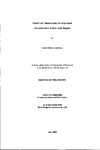Pulsed Field Magnetometry for High-Speed Characterisation of Rare Earth Magnets
| dc.contributor.author | Cornelius, Robin Nathan | |
| dc.contributor.other | Faculty of Science and Engineering | en_US |
| dc.date.accessioned | 2013-11-13T11:45:03Z | |
| dc.date.available | 2013-11-13T11:45:03Z | |
| dc.date.issued | 2005 | |
| dc.identifier | NOT AVAILABLE | en_US |
| dc.identifier.uri | http://hdl.handle.net/10026.1/2686 | |
| dc.description.abstract |
Pulsed Field Magnetometers (PFM) offer large advantages over conventional magnetic characterising equipment for high speed measurement of modern permanent magnet materials. A lack of systematic design procedure and many perceived problems has prevented adoption of the technique. This thesis examines in detail the system components of a PFM, the perceived problems and presents design methodology for critical system components and data processing methods to recover accurate and repeatable material characteristics. A method for the design of position insensitive gradient coils is presented and compared to a conventional design. By using an inverse Biot-Savat simulation, the coupling from each turn of the pickup coil to the point of interest is calculated and optimum winding positions calculated for homogenous pickup. Problems of thermal expansion due to differential temperatures are considered and a method developed to remove the problem using cooling. The possible origin of the zero signal is presented and a method for nulling of gradient coils to remove this zero signal using an external potentiometer is considered and results demonstrated. The design and construction of field generation coils are examined in detail and a complete method is developed for the determination of magnetic and electrical characteristics for a given geometry. The effect of skew due to conductor thickness is considered in the model to ensure optimum homogeneity of applied field and the size of the conductor wires are accounted for in a multifilament model. A software tool is created to implement these design methods and the results are compared to physical models with good agreement. The offline processing of PFM data is considered and methods for the removal of the effects of eddy currents are presented and results demonstrated. By measuring the sample at different rates of change of applied field, two measurements with different eddy current components are generated. This data can be then used to calculate and remove the eddy current component. Careful consideration is given to time aligning the data and insuring the stability of the differential equations. Possible methods for calibration of a PFM are examined in detail and compared. Methods include standard sample, calibration transfer coils, and the removal of eddy currents in calibration samples by using representative eddy currents in non-magnetic materials. Standard sample and transfer coils have proved successful and produced results with a high degree of agreement compared with conventional systems. A prototype industrial PFM was built, designed for the high speed characterisation of rare earth materials in an industrial environment. Details of the system are described. Extensive industrial trials were carried out and results from the trials are discussed in detail. Comparisons are made with conventional systems and the PFM is found to have better repeatability and comparable accuracy. Overall the PFM was highly successful and has proved the technology as viable for high speed characterisation of permanent magnet materials. Future work describes improvements to the measurement technique to achieve higher accuracy, such as accounting for distributed demagnetisation factors, and describes the next generation of PFM machines that are to be built due to this work. | en_US |
| dc.description.sponsorship | Hirst Magnetic Instruments Ltd. | en_US |
| dc.language.iso | en | en_US |
| dc.publisher | University of Plymouth | en_US |
| dc.title | Pulsed Field Magnetometry for High-Speed Characterisation of Rare Earth Magnets | en_US |
| dc.type | Thesis | |
| plymouth.version | Full version | en_US |
| dc.identifier.doi | http://dx.doi.org/10.24382/3363 |
Files in this item
This item appears in the following Collection(s)
-
01 Research Theses Main Collection
Research Theses Main


